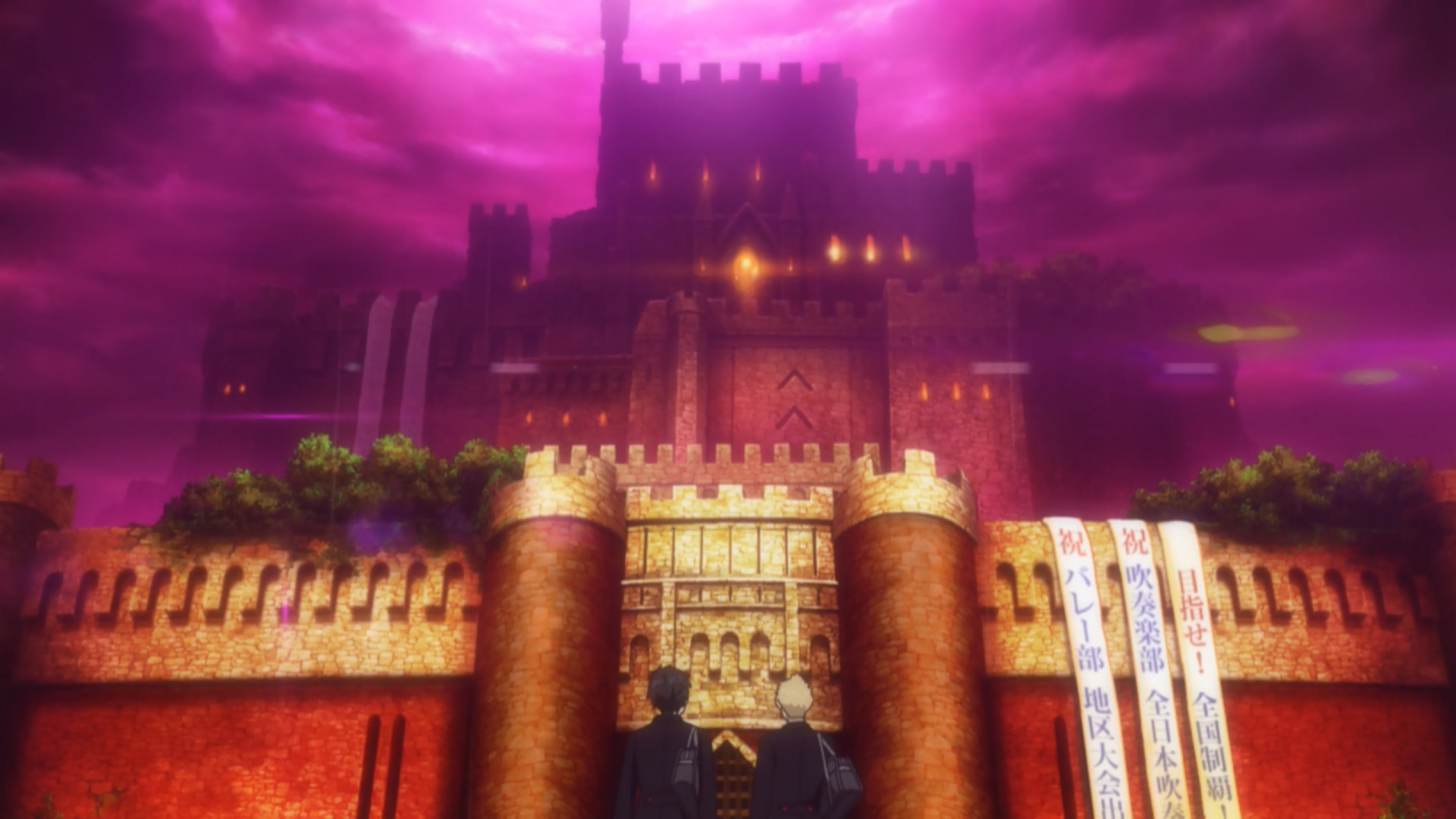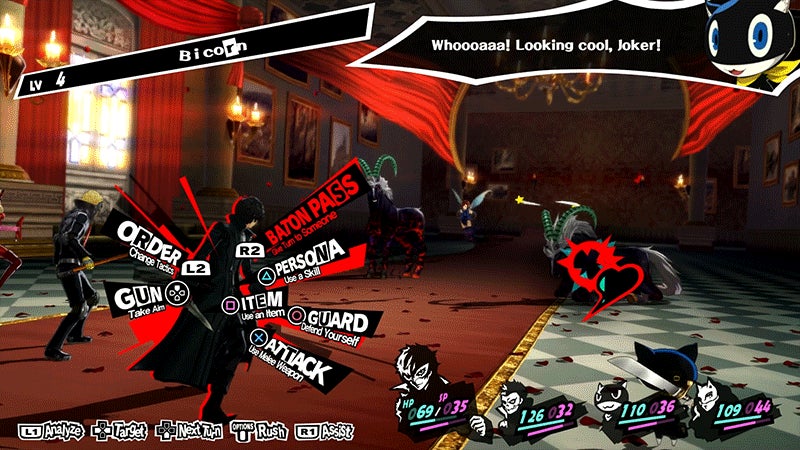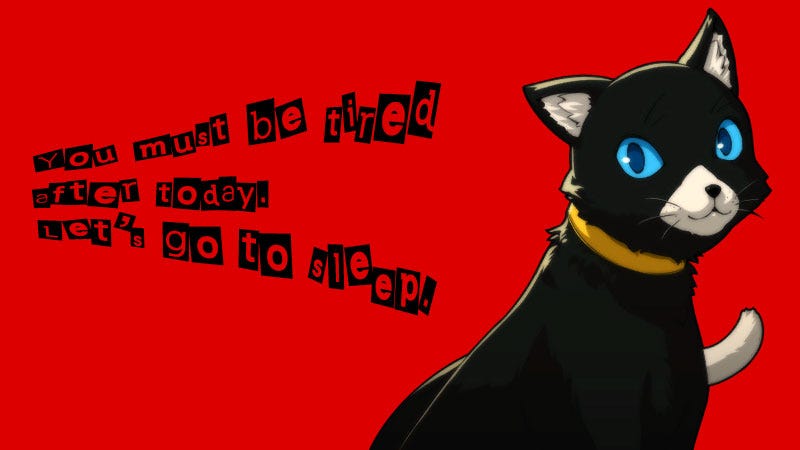Persona 5
Taking off the vein of prior Personas, a protagonist moves into a new region, and becomes embroiled in a new strange world, relying on the power of his inner self along with his friends in order to overthrow the corrupt and take their hearts, as the Phantom Thieves of Hearts.
Basic Details
Developer: Atlus
Platform: Playstation 3, Playstation 4
Rating: M (Blood, Drug Reference, Partial Nudity, Sexual Themes, Strong Language, Violence)
Release Date: Japan: September 15, 2016 | Worldwide: April 4, 2017
Players: 1
Playable Character(s)
Protagonist

This time around, the protagonist could be described as anime Harry Potter. In game, he’s known as “Frizzy Hair”, or Akira Kurusu according to the manga; however, like every Persona game, you can choose his first and last name. A transfer student due to “past issues”, you arrive in Shibuya under the care of your new guardian, tackling school life and ending up entangled in a strange world involving the hearts of criminals and the world itself, awakening the persona Arsene and creating the Phantom Thieves of Hearts.
Protagonist’s Team

Throughout the game, the party grows as new allies join the group. Near the start, a companion joins you in the fray, and more students discover their rebellious nature and reveal their new forms, each unlocking a unique thief outfit and persona, based on rogues of history and legend. The scenes are gripping as they break free, and I won’t say anything more to avoid spoiling.
Gameplay
General
The gameplay is really in two phases: school life – which takes in dealing with school, part-time jobs, friends and allies, and just surviving day-to-day – and the Palace – dungeons that represent the twisted desires of your targets, where you take on a combination of stealth and combat to reach your goal, their Treasure.
Dungeons

The dungeons pop up on certain dates, Palaces that represented the twisted views and desires of the target. These dungeons are a static map, filled with treasure chests and shadows, along with various locks or effects, like lasers and cameras. The objective is to make your way through the Palace to the Treasure, and steal it from your target. Being caught by traps or seen by shadows increases the security of the Palace, and if it hits 100%, you will be kicked out for the day; the security can be decreased by ambushing enemies, and it can be avoided by ambushing enemies and not setting off the lasers, cameras, or alarms. After stealing the Treasure, the Palace will collapse, leaving you unable to return to it.
There is another style of dungeon known as Mementos, representative of the hearts of the public. This randomly generated dungeon grows as you complete Palaces, and can be accessed at any time. Across the game, you receive requests to take specific hearts in here for rewards. It is a place that can be used for leveling in between Palaces and is effected by the weather going on in the real world, considering it.
Combat

Combat involves your protagonist and up to three allies taking on various shadows and bosses. Each character, excluding the main character, has a persona that is associated with an element, giving them spells for that element and weakness to an opposing element, along with having a melee and a ranged weapon. Enemies themselves have various weaknesses and resistances, later ones even being able to drain certain elements or repel them back at the party. However, by striking weaknesses, you can earn extra rounds of combat, and if the entire group of enemies is knocked down, you can hold them up like a bank robbery, demanding money, items, or even for them to join the party. How? Remember before when I mentioned before about the main character being separate? That’s because he possesses a unique ability to change personas, allowing him to swap out what skills he knows and what he is weak/resistant to. By persuading shadows in combat, you can increase the number of personas he can change out.
The downside is that everything does hinge around the protagonist; if he does fall in combat, then you will suffer a game over, either returning to the closest safe room or back to the title screen. Protect him with everyone else’s life.
Stats

Outside of combat, there are five statistics that you need to cultivate: Charm, Kindness, Guts, Knowledge, and Proficiency. These statistics improve through various activities and social links, such as answering questions in class, making thieves’ tools, or even taking a bath. This is something to be balanced with social links and the Palaces, considering that they grant access to levels of Social Links along with various other bonuses.
Outside Life

Beyond the dungeons, you play as a high school student, trying to get through day-to-day life. You interact with your friends and other associates, answer questions in class, work on improving your personality, such as charm and knowledge, working part-time jobs, and go from day to day. Starting in April, you go through the Japanese school year, balancing being a “normal” teenager with your forays into the Palaces.
Personas

Akin to the enemy Shadows that you face, you and each of your comrades wield Personas, manifestations of the rebellious nature to oppose the oppression. Each represents a famous outlaw, such as Arsene Lupin or Zorro. As you encounter shadows, you can negotiate and have them join your team, allowing the main character to swap out the persona they use. These personas can also be fused into stronger personas, or sacrificed to power up others. Each persona has their own strengths, weaknesses, and skills.
Confidants

As you go through the game, you meet people that you establish bonds with, from your party members to your caretaker to fellow students and beyond. These are called Confidants. You can spend time with a person to build up their rank up to 10, learning their personal story. As with the older games, the higher the Confidant, the stronger personas of the corresponding arcana are when first fused. However, this game adds an additional layer, where the individual Confidants grant you abilities as you level up: the doctor who sells you medicine gives you a better stock, your allies will follow up your attacks and back up your negotiations, and your classmate helps boost the amount of experience you earn in combat.
Thieves Guild

Taking from Persona 4 Golden, the Thieves Guild is the connection between your game to the online community of other Phantom Thieves. During the days, you can see how other players spent their time, during questions in class how players answered, and even in combat, should an ally be taken hostage by foes the Thieves Guild may help bail them out. Definitely a nice add to give a bit more guidance to such an open game.
Visual
The visuals are a definite step up from the prior Persona games, considering that there has been a major hardware boost. Both Arekuzanra and MonocleDan played on the Playstation 4, leading to the highest level of quality. The character models and settings seem to use the same design program that was used previously on Catherine, leading to the 3D models looking very smooth, and the battles fluid.
The costumes for the party members are phenomenal, each having their own unique style but tying into the Phantom Thieves theme. Each persona and shadow, though several designs have carried over from the older games in the series. Each character and named NPC has their own design and style, making them easily identifiable.
The settings are very identifiable in terms of real world Japan, and help pull in the feeling of the duality between corrupted reality and the common world. The dungeons each have their own unique layout and style, building up the atmosphere, and the puzzles and platforming are reflective of the palace.
Similar to older games, there are hand drawn animated scenes that play at important parts, and the art style adds to the dark themes of the game. They are rare enough that each one is a treat to see.
Audio
Similar to the other Shin Megami Tensei games, Shoji Meguro is the composer of the soundtrack. The overall theme is a combination of jazz and hip hop, leading to a very modern urban sounding track, upbeat quite a bit of the time. The various dungeons themes have a layer of mystery and suspense, melding into your sneaking around.
The vocals for the opening theme, along with the battle theme and other songs, are done by Lyn Inaizumi, who really brings a unique flavor. Her voice flows very well with the instrumentals, and lend themselves to creating strong pieces for the game.
Opinion Corner
Arekuzanra
As much of a Persona fan as I am, I actually almost missed the launch of this game. I ended up getting my game a week after the American release because I pretty much thought it was never going to be released (so many teasers…). My experience with the Persona series started with Persona 3: FES, then moved to Persona 4, and now here we are with Persona 5.
With previous Persona games in mind, I was glad to see that nostalgia factor come into play. However, when I had played Persona 3 and 4, I had played them as a teenager in middle/high school who was able to relate to the characters. Now I’m a 24-year-old working a full time job and suddenly I find it a lot harder to relate to the protagonists of the game. A lot of their dramas, their thoughts, and their feelings are that of a typical high schooler’s (except they also fight shadows and risk their lives to change the world around them). I definitely applaud that Atlus has been able to keep realistic teenage characters… but it really was an eye opener for me to feel annoyed with these teenage protagonists rather than feeling like I could relate to them.
At the time of writing this, I’ve gotten about 75 hours into the game and some of the hints are showing me that I’m getting closer to finishing it. I would recommend this game even to someone who lives a busy lifestyle because it’s an easy game to be able to pick up and put down as long as you’re someone who can be mindful of where you are in the story. The only struggles I found myself facing when I went long periods of time between play sessions was when it came time for the high school exams and they would ask me questions that I had answered forever ago and couldn’t quite remember the answer of. A lot of the questions also revolve around Japanese history/culture as well as subjects that I haven’t touched in years… so I found myself surprisingly struggle to be a high school student in Japan.
I feel like when they translated the game to English, there were some quips and concepts that had been lost. One of the protagonists, Ann, is technically a foreigner and was fluent in English, but I feel like we missed out on that opportunity with the game already being in English. With that in mind, I’m thinking possibly of doing my second play-through/new game plus in Japanese to be able to see what kind of differences there may have been between the two versions. Additionally, I was also extremely upset with some of the pronunciations of character names, particularly Ryuji’s last name, Sakamoto; Ann’s last name, Takamaki; and one character you meet later on, Makoto Niijima. There were a few other blunders in pronunciation as well, but I sorta just sighed, accepted it, and moved on. I look forward to a second play-through in Japanese for even just that alone.
Overall, this game was fantastic. It has a lot of catchy music, the visuals are very bright and colorful (despite the themes of the game being very dark), and it definitely brought back those nostalgic Persona feelings. Makes me want to pick up Persona 3 and 4 again now that I’m older as well!
Rating: 4.6/5.0
MonocleDan
Yes.
I got into Persona, like most Americans, with the advent of Persona 3. I traded it out for Persona 3 FES, and hopped on Persona 4 when it became available. Upon the announcement of this game, I preordered the “Take Your Heart” edition, and waited with bated breath to get it.
I love the gameplay, the art, the balance of fantasy and reality, I can not say enough good things about this game. It’s easier to get into than the older ones, plus the improvements make it a great introduction for any RPG players. I would recommend this to anyone who likes games, mystery, and a bit more mature setting.
Why does it not get a 5, you might ask?


